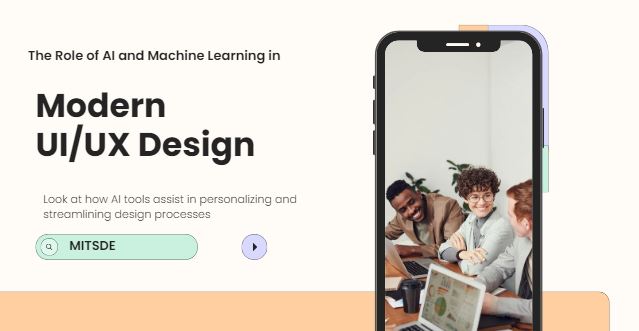
In the rapidly evolving world of UI/UX, artificial intelligence (AI) and machine learning (ML) are reshaping how designers create user-centered, engaging digital experiences. As user expectations for personalized, seamless interactions rise, AI and ML technologies are stepping up to transform traditional design processes by enabling customization, automation, and data-driven design improvements. For anyone interested in learning the art and science behind these advancements, a UI UX design course or UI UX design training like the ones offered by MIT School of Distance Education (MITSDE) can provide the tools and insights to stay competitive in this dynamic field.
Let’s dive into the roles AI and ML play in modern UI/UX design and explore how they streamline workflows, enhance personalization, and provide insights that empower designers to create exceptional user experiences.
1. Creating Personalized User Experiences
AI algorithms analyze extensive user data, including browsing habits, preferences, and behavior, allowing designers to build unique, individualized interfaces for users. By predicting user needs and preferences, these tools can automatically adapt content, visuals, and even layouts to suit each individual’s interaction style. For instance, e-commerce sites like Amazon and social media platforms like Instagram use AI to display personalized content based on users’ past interactions.
Learning personalization through a UI/UX design course at MITSDE enables designers to grasp how to incorporate user behavior data into their projects, making their designs feel more relevant and engaging. Courses like UI and UX design course and UI UX classes emphasize how AI-driven personalization enhances user experience, making it more intuitive and tailored.
2. Data-Driven Design Decisions
Making informed design choices is fundamental to effective UI/UX. AI-driven analytics tools can help designers make these decisions by examining large datasets and identifying patterns in user interactions. Heatmaps, for example, reveal which areas of a webpage attract the most attention, giving designers insight into where to position critical elements.
MITSDE’s UI UX design classes explore these techniques, focusing on data-driven design. With this knowledge, designers can better understand user interactions and create interfaces that align with user preferences, leading to designs that are as functional as they are visually appealing.
3. Enhancing User Testing and Feedback with AI
User testing has traditionally been time-consuming, but AI is changing that by enabling faster and more accurate testing processes. Through machine learning, designers can analyze user feedback in real-time, identifying pain points and preferences. AI tools can even simulate user behavior to help designers optimize interfaces before launching them to a live audience.
This kind of training is a key component of UI UX design training programs like those at MITSDE. By understanding AI-powered user testing, designers can conduct efficient testing, adjust designs based on real-time feedback, and create superior user experiences that are tested for effectiveness before they reach users.
4. Predictive Analytics for Optimized User Journeys
AI’s predictive analytics tools forecast user behavior, allowing designers to develop interfaces that preemptively address user needs. Machine learning algorithms analyze historical user data and behaviors to predict what users might do next, offering designers insights into which features, content, or pathways users are likely to engage with.
Predictive design is especially powerful for e-commerce and content-heavy platforms where guiding users efficiently can significantly impact engagement and conversions. For example, a retail website might recommend products based on the shopper’s browsing history, streamlining the purchase journey. This valuable skill set is covered in UI UX design courses like those offered by MITSDE, which teach designers how to anticipate and cater to user expectations.
5. Automating Design Tasks with AI Tools
From resizing elements for responsive design to selecting color palettes, AI-based design tools automate repetitive tasks, giving designers more time to focus on innovation. For instance, tools like Adobe Sensei and Sketch use AI to streamline tasks such as layout creation, prototyping, and color selection based on user preferences and best practices.
Automation can improve both productivity and design quality, a dual benefit that UI and UX design courses at MITSDE emphasize. With automation skills, designers can quickly adjust designs across platforms, saving time and reducing the chance of errors.
6. Voice and Conversational Interfaces Powered by AI
As voice-activated technology continues to grow, AI enables designers to create conversational interfaces that users can interact with through voice commands. AI-powered natural language processing (NLP) makes it possible for devices like Alexa and Google Assistant to understand and respond accurately to spoken commands.
Designing for voice interfaces requires a unique skill set, as it differs significantly from traditional visual design. UI UX classes at MITSDE include training on voice and conversational UI, teaching designers how to create intuitive experiences for voice-driven applications that align with emerging user expectations.
7. Adaptive Interfaces for Real-Time Personalization
AI allows designers to create adaptive interfaces that respond to user actions in real time. Using machine learning, interfaces can adjust layouts, content, and functionality based on how a user interacts with the application. For example, if a user frequently uses certain features of an app, those features can be highlighted or made more accessible.
This capability creates an interactive, fluid experience that users find highly intuitive, and learning how to implement such adaptive elements is a focus in UI UX design training at MITSDE. As designers become more skilled in these techniques, they can craft dynamic interfaces that feel personal and engaging.
Why Training in AI for UI/UX is Vital for Modern Designers
The influence of AI and ML in UI/UX design will only continue to grow, pushing the boundaries of what’s possible in design. As these technologies evolve, so will user expectations, and designers must stay on top of these changes to remain competitive. Enrolling in a UI UX design course at MITSDE can give designers a solid foundation in AI-driven tools and strategies, preparing them to craft innovative, user-centered designs that resonate with users.
Whether you’re looking to upgrade your skill set or start a career in UI/UX, UI UX design classes and UI UX design training at MITSDE offer practical experience with AI-powered design tools, data-driven strategies, and personalization techniques that can transform your approach to design.
Final Thoughts
AI and machine learning are revolutionizing UI/UX design by creating personalized, efficient, and data-driven design processes. As technology progresses, AI’s role in design will expand, providing new opportunities to streamline workflows and enhance user experience.
For those serious about advancing their design skills, enrolling in a UI and UX design course or UI UX design classes at MITSDE can open doors to cutting-edge knowledge in AI, machine learning, and UI/UX design, positioning you to succeed in an industry that values innovation and user-centered thinking.



